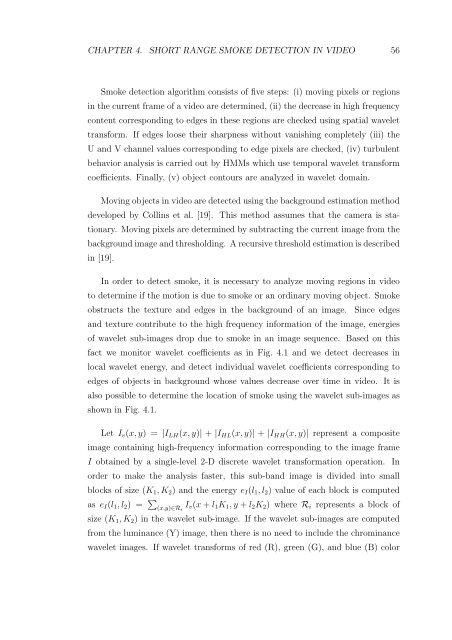Fire Detection Algorithms Using Multimodal ... - Bilkent University
Fire Detection Algorithms Using Multimodal ... - Bilkent University
Fire Detection Algorithms Using Multimodal ... - Bilkent University
Create successful ePaper yourself
Turn your PDF publications into a flip-book with our unique Google optimized e-Paper software.
CHAPTER 4. SHORT RANGE SMOKE DETECTION IN VIDEO 56Smoke detection algorithm consists of five steps: (i) moving pixels or regionsin the current frame of a video are determined, (ii) the decrease in high frequencycontent corresponding to edges in these regions are checked using spatial wavelettransform. If edges loose their sharpness without vanishing completely (iii) theU and V channel values corresponding to edge pixels are checked, (iv) turbulentbehavior analysis is carried out by HMMs which use temporal wavelet transformcoefficients. Finally, (v) object contours are analyzed in wavelet domain.Moving objects in video are detected using the background estimation methoddeveloped by Collins et al. [19]. This method assumes that the camera is stationary.Moving pixels are determined by subtracting the current image from thebackground image and thresholding. A recursive threshold estimation is describedin [19].In order to detect smoke, it is necessary to analyze moving regions in videoto determine if the motion is due to smoke or an ordinary moving object. Smokeobstructs the texture and edges in the background of an image. Since edgesand texture contribute to the high frequency information of the image, energiesof wavelet sub-images drop due to smoke in an image sequence. Based on thisfact we monitor wavelet coefficients as in Fig. 4.1 and we detect decreases inlocal wavelet energy, and detect individual wavelet coefficients corresponding toedges of objects in background whose values decrease over time in video. It isalso possible to determine the location of smoke using the wavelet sub-images asshown in Fig. 4.1.Let I v (x, y) = |I LH (x, y)| + |I HL (x, y)| + |I HH (x, y)| represent a compositeimage containing high-frequency information corresponding to the image frameI obtained by a single-level 2-D discrete wavelet transformation operation. Inorder to make the analysis faster, this sub-band image is divided into smallblocks of size (K 1 , K 2 ) and the energy e I (l 1 , l 2 ) value of each block is computedas e I (l 1 , l 2 ) = ∑ (x,y)∈R iI v (x + l 1 K 1 , y + l 2 K 2 ) where R i represents a block ofsize (K 1 , K 2 ) in the wavelet sub-image. If the wavelet sub-images are computedfrom the luminance (Y) image, then there is no need to include the chrominancewavelet images. If wavelet transforms of red (R), green (G), and blue (B) color
















